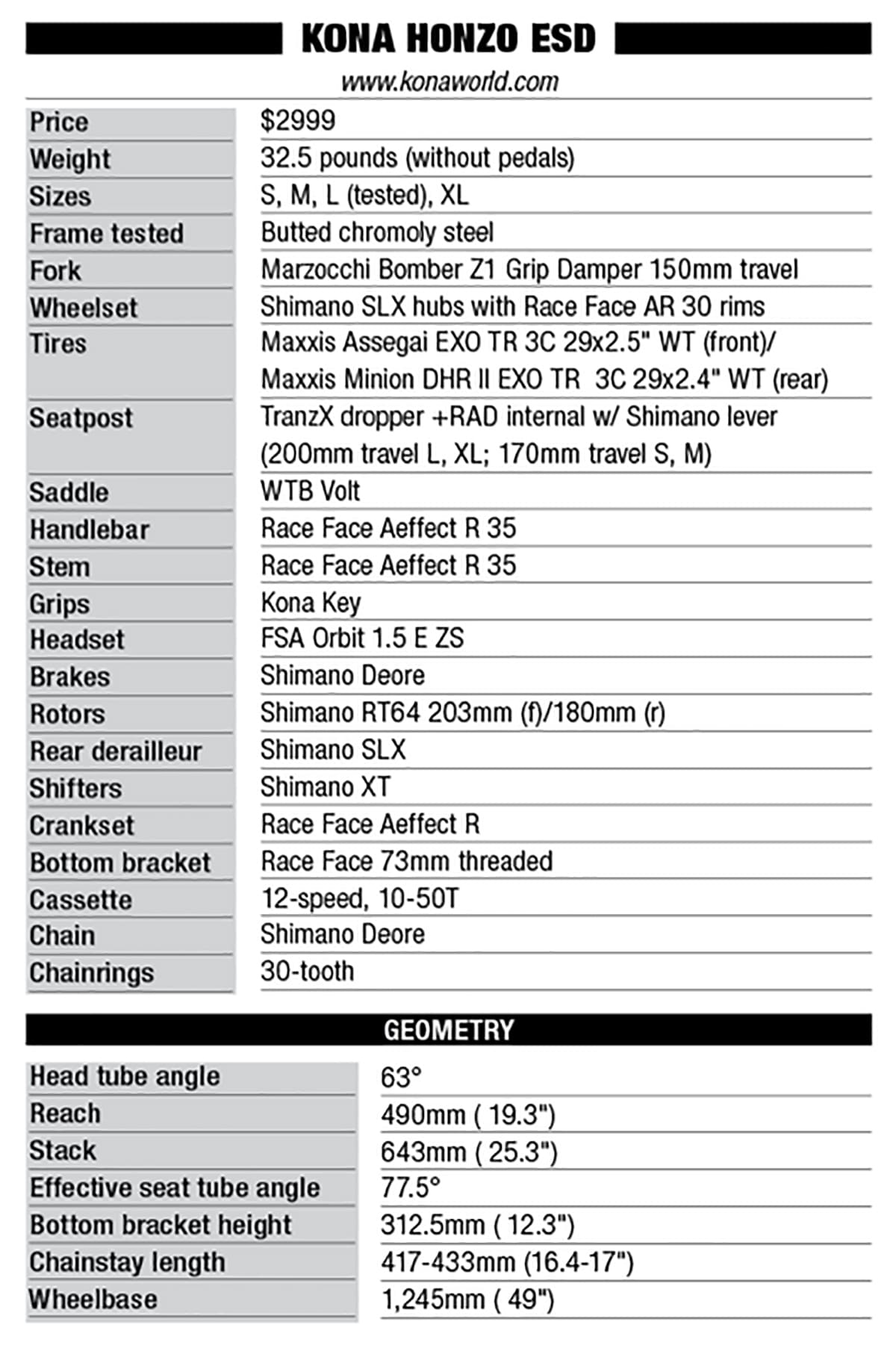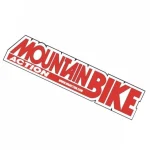LONG TERM REVIEW: KONA HONZO ESD
A hardtail with the heart of an enduro bike
 Photos by Traece Craig
Photos by Traece Craig
We have been longtime fans of the incredibly capable and versatile Kona Honzo line, so when the slacker and more aggressive Honzo ESD was released, we just had to test it. ESD stands for “Extra Slack, Dude,” and it is very slack indeed, especially for a hardtail. There are plenty of riders out there who love the simplicity of a hardtail or want a nicely spec’d bike without spending a fortune. The Honzo ESD is all of that in an aggressive, enduro-focused package that’s designed to excel in steep, gnarly terrain.

FRAME
The Honzo ESD’s frame is made of butted chromoly steel with gussets at the downtube/head-tube junction and at the top of the seat tube for a little extra big-send strength. Its thru-axle Boost-width rear dropouts are a sliding style with an adjuster screw and two pinch bolts to lock it down.
Geometry is where the ESD really separates itself from the rest of the Honzo line. As the ESD name suggests, its head angle is indeed slack at 63 degrees, and it has a reach of 490mm in a size large—those are enduro bike numbers, and exactly what you will find on Kona’s 170mm-travel full-suspension Process X models. The seat tube angle is similarly aggressive in the opposite direction at 77.5 degrees, and it’s short, too, allowing for long-travel dropper posts. Although the bike is spec’d with a 150mm-travel fork, you can put on a longer-travel fork for an even slacker setup. Sliding dropouts are typically used for single-speed chain adjustment, but on this bike, they also offer 16mm of chainstay adjustment for handling changes. Even so, the chainstays are short at 417–433mm, especially when paired with the long reach.

COMPONENTS
The ESD’s build is well thought out and ideal for the aggressive bike that it is. Its Shimano drivetrain is an interesting mix of SLX and XT. It’s interesting, because Kona pairs the XT shifter to an SLX rear derailleur and cassette—backwards from what’s typically seen. According to Kona, shifters last a very long time, while derailleurs are a more frequently replaced wear item, so they put the value in the part you’ll keep longer. This sort of makes sense to us, and if nothing else, the SLX rear derailleur performs exactly the same as the XT. Shimano Deore four-piston brakes keep the bike’s speed in check and are a standout feature (more on this later).
The wheels are another great spec that really adds to the overall package. Shimano’s SLX hubs engage quickly and smoothly, but, best of all, roll with silence after about 8–10 mph. The hubs are laced to 30mm-wide Race Face tubeless-ready rims. Kona wisely outfitted the Honzo ESD with one of our favorite all-around tire combos—Maxxis 2.5-inch Assegai in front and 2.4-inch Minion DHR II in the rear. Another cool spec is the TranzX dropper post with Shimano lever. The post on the size large and extra-large models has a whopping 200mm of drop. Sizes small and medium see a 170mm-travel dropper-post spec. The bar, stem and cranks are all Race Face Aeffect-level parts.

SUSPENSION
Since the Honzo is a hardtail, it relies solely on a 150mm-travel Marzocchi Bomber Z1 fork with a Grip damper for suspension. The Z1 may be Fox’s value line of suspension, but it’s very high quality and works very well overall. The frame’s seatstays are flattened, offering a passive form of suspension in the form of flex.

CLIMBING
Since the Honzo is a hardtail, one might assume that it’s a fantastic climber, but it’s not really this bike’s forte. It’s not a bad climber; it’s just not a stellar one. The 77.5-degree seat angle feels even steeper than on full-suspension bikes, because there is no rear suspension to create sag and slacken it. Although it feels great on smooth, steady climbs, some riders felt it put the saddle in their way on technical ascents. We learned to drop the saddle when navigating ledges and steps to allow room for the extra body English that’s needed.
Yes, it’s efficient on smooth surfaces, but not as fast as a good full-suspension bike in the rough. Overall bike weight and geometry work against it, too, compared to its Honzo siblings. The super-slack front end makes for a flopping front wheel at low climbing speeds. It hunts and pecks its way up slower climbs where a steeper bike tracks. The bottom bracket is on the low side, too, and paired with 175mm cranks, so you have to watch your pedals while climbing in the rocks. Short chainstays put a lot of weight over the rear wheel, giving it good traction when little is available. When we pushed the rear wheel back in the sliding adjusters, traction fell off a touch, and we had to compensate with more careful weight placement. The Honzo ESD is in its happy climbing place while on smoother fire-road ascents that link gnarly descents.

DESCENDING
When the trail turns downward, the Honzo ESD really comes to life. The steeper and faster the trail, the better. The enduro geometry that holds it back on climbs gives this bike wings on the steeps. A long front center paired to the slack head angle really offers a lot of confidence on trails so steep that you have to fight to keep from skidding down them. Wrecking crew test riders had no trouble keeping full-suspension bikes in sight in smoother terrain, but all had bulging eyes the first time they charged into a chunky rock garden at speed. Even with the compliance from the steel frame and suspension from the fork, you simply can’t lean back and let it eat the gnar like you can on a full-suspension bike.
We all blew our feet off the pedals a few times until we recalibrated our brains to hardtail mode. It requires finesse to get through the rough, but that’s also what makes the bike so incredibly fun to ride. You are forced to actually ride the bike and carefully pick lines.
Cornering is interesting with the short chainstay, long front center and slack head angle. On flat corners without a berm, weight transfer between the front and rear wheels needs to be carefully monitored. Unless the trail is steep, there is little weight on the front end relative to a trail-focused bike. We spent the first half of our test period with the dropouts in the middle of the adjustment range and the last half with them all the way back. The short setup is playful and snappy, with an edge in jumpy, flowy, bike-park-style settings. Out in natural terrain, riders strongly preferred the full rearward position. The bike tracked better and required less attention while cornering. Even on ultra-steep, butt-buzzing-on-the-rear-tire trails, it just seemed to track more consistently.
Shimano’s Deore four-piston brakes are absolutely fantastic. They offer massive power in a very easy-to-control manner, never make noise and never fade on long descents. These might be some of, if not the best brakes on the market regardless of price. We really appreciated the 200mm-drop seatpost, too, since this bike is so at home in the steeps. And, we couldn’t find fault with the Maxxis Assegai/Minion DHR II tire combo; these tires are simply stellar in every category other than rolling speed.
MODS AND UPGRADES
With a dialed build that’s totally appropriate for the bike’s intended use, there is little we would change. Our larger-handed test riders swapped the skinny grips for something larger in diameter. And, we wish Kona used a better chainstay chain guard to keep chain slap at bay, but it isn’t terrible. Riders who climb in rocky terrain might want to swap the 175mm crankarms for something shorter, but it’s not a necessary mod, either.
BOTTOM LINE
We absolutely loved riding the Honzo ESD and couldn’t stay off of it, even when other full-suspension bikes were available. And, we are very happy that Kona chose to make this bike out of steel for ride quality and durability reasons. There is something special about riding a bike like this that forces your full attention and skills. And, because you really have to ride it hard, this bike is geared more towards an experienced rider who will charge in challenging terrain. Beginners might like the geometry in the steeps, but will likely find cornering much easier on standard Honzo models.
CATEGORY: Enduro
SUSPENSION: 150mm (front)
TIRE SIZE: 29″





